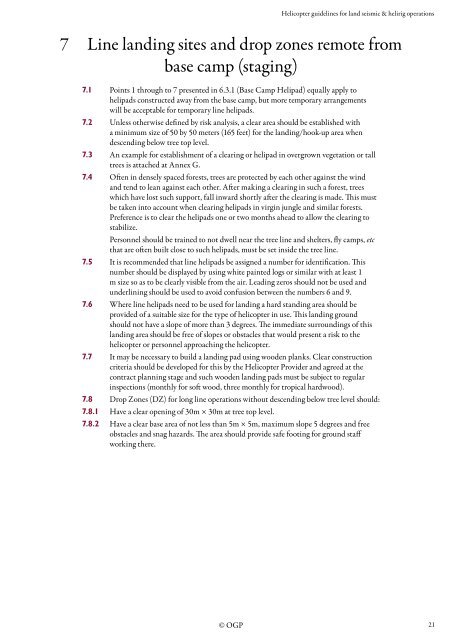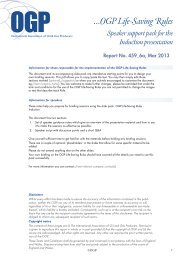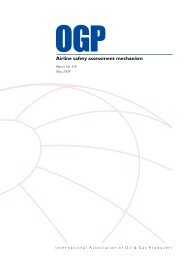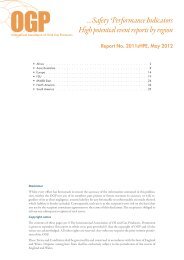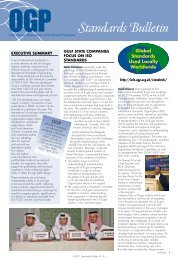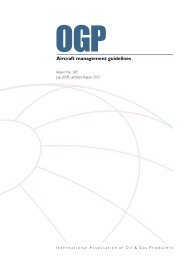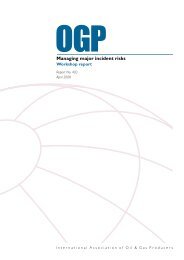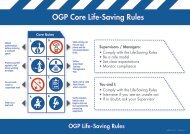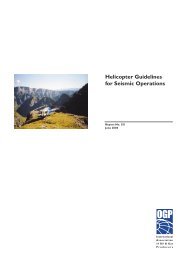Helicopter guidelines for land seismic & helirig operations - OGP
Helicopter guidelines for land seismic & helirig operations - OGP
Helicopter guidelines for land seismic & helirig operations - OGP
You also want an ePaper? Increase the reach of your titles
YUMPU automatically turns print PDFs into web optimized ePapers that Google loves.
<strong>Helicopter</strong> <strong>guidelines</strong> <strong>for</strong> <strong>land</strong> <strong>seismic</strong> & <strong>helirig</strong> <strong>operations</strong><br />
7 Line <strong>land</strong>ing sites and drop zones remote from<br />
base camp (staging)<br />
7.1 Points 1 through to 7 presented in 6.3.1 (Base Camp Helipad) equally apply to<br />
helipads constructed away from the base camp, but more temporary arrangements<br />
will be acceptable <strong>for</strong> temporary line helipads.<br />
7.2 Unless otherwise defined by risk analysis, a clear area should be established with<br />
a minimum size of 50 by 50 meters (165 feet) <strong>for</strong> the <strong>land</strong>ing/hook-up area when<br />
descending below tree top level.<br />
7.3 An example <strong>for</strong> establishment of a clearing or helipad in overgrown vegetation or tall<br />
trees is attached at Annex G.<br />
7.4 Often in densely spaced <strong>for</strong>ests, trees are protected by each other against the wind<br />
and tend to lean against each other. After making a clearing in such a <strong>for</strong>est, trees<br />
which have lost such support, fall inward shortly after the clearing is made. This must<br />
be taken into account when clearing helipads in virgin jungle and similar <strong>for</strong>ests.<br />
Preference is to clear the helipads one or two months ahead to allow the clearing to<br />
stabilize.<br />
Personnel should be trained to not dwell near the tree line and shelters, fly camps, etc<br />
that are often built close to such helipads, must be set inside the tree line.<br />
7.5 It is recommended that line helipads be assigned a number <strong>for</strong> identification. This<br />
number should be displayed by using white painted logs or similar with at least 1<br />
m size so as to be clearly visible from the air. Leading zeros should not be used and<br />
underlining should be used to avoid confusion between the numbers 6 and 9.<br />
7.6 Where line helipads need to be used <strong>for</strong> <strong>land</strong>ing a hard standing area should be<br />
provided of a suitable size <strong>for</strong> the type of helicopter in use. This <strong>land</strong>ing ground<br />
should not have a slope of more than 3 degrees. The immediate surroundings of this<br />
<strong>land</strong>ing area should be free of slopes or obstacles that would present a risk to the<br />
helicopter or personnel approaching the helicopter.<br />
7.7 It may be necessary to build a <strong>land</strong>ing pad using wooden planks. Clear construction<br />
criteria should be developed <strong>for</strong> this by the <strong>Helicopter</strong> Provider and agreed at the<br />
contract planning stage and such wooden <strong>land</strong>ing pads must be subject to regular<br />
inspections (monthly <strong>for</strong> soft wood, three monthly <strong>for</strong> tropical hardwood).<br />
7.8 Drop Zones (DZ) <strong>for</strong> long line <strong>operations</strong> without descending below tree level should:<br />
7.8.1 Have a clear opening of 30m × 30m at tree top level.<br />
7.8.2 Have a clear base area of not less than 5m × 5m, maximum slope 5 degrees and free<br />
obstacles and snag hazards. The area should provide safe footing <strong>for</strong> ground staff<br />
working there.<br />
© <strong>OGP</strong><br />
21


